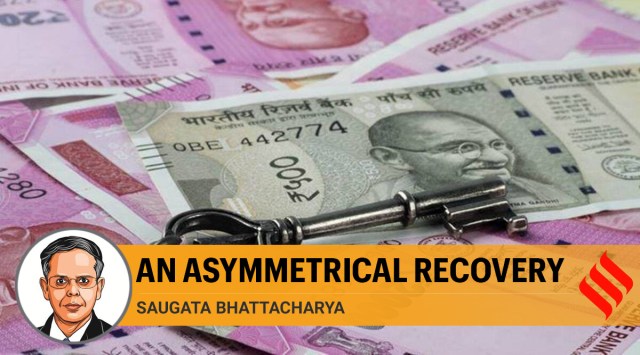- India
- International
GDP growth is being driven by larger firms. Smaller ones continue to suffer, need policy attention
Policy coordination between the Centre and states will be crucial for implementing this ambitious reform agenda.
 There is little data currently available on the smaller and unlisted companies, which form the vast majority of enterprises in India, let alone the informal sector.
There is little data currently available on the smaller and unlisted companies, which form the vast majority of enterprises in India, let alone the informal sector.The National Statistical Office will release the second advance GDP estimates for 2020-21 at the end of February. The first advance estimate had, in early January, forecasted a contraction of 7.7 per cent in 2020-21. This was due largely to an expected, sharp contraction in both industry and services. The second advance estimates are likely to project a lower growth contraction, between 6-7 per cent — our own forecast been upgraded to 6.6 per cent.
These advance estimates are projections based on extrapolations from limited available data — initially available till October and November, and thereafter till December or January of the current financial year. A large part of the extrapolation exercise involves the financial results of corporates, which are declared quarterly (a substantial set of large and mid-sized listed companies will have declared their results at the time of writing this). Broadly, a proxy for nominal gross value-added (GVA) by the industry and services segments (and hence growth) can be derived from the sum of operating profits and employee costs for companies that operate in the respective segments.
Sales of a set of 736 companies which we track (excluding finance, petroleum and trading companies) have grown 8.5 per cent (year-on-year), driven largely by manufacturing and IT companies, as against largely flat growth in the second quarter and a 25 per cent contraction in the first quarter. Even more noticeable is the rise in the operating profits of these companies — 34 per cent overall (and 51 per cent for manufacturing) due to a rise in operating profits margins for companies across sectors (given that raw materials costs have not risen as fast). Add to this a further (although more muted) increase in salaries and employee costs, and the presumptive GVA of these sets of companies had increased 18 per cent (y-o-y) in the third quarter (versus 6 per cent in the second quarter, after a contraction of 14 per cent in the first quarter). This will be reflective of non-agricultural (industrial and services sector) growth for the first three quarters of 2020-21.
These nominal growth rates then need to be adjusted for inflation by using “GDP deflators”, which are a weighted average of the wholesale price index and the consumer price index. For the third quarter, the deflator computes to 3.2 per cent using a broad 40:30 share mix of the respective WPI:CPI inflation prints. The real growth in the companies’ results in the third quarter will, therefore, have been 14.8 per cent.
We need to emphasise that in addition to results-based data, the GDP estimation process uses many more volume-based indicators like the Index of Industrial Production (IIP), freight and transport data, consumption of fuel, electricity demand, export and import indices. IIP growth in the third quarter, for instance, averaged 1.1 per cent. Added to this will be the agricultural sector growth, which we expect to be 3.2 per cent for the third quarter and 3.3 per cent for the full year (with the strong possibility of it being higher).

One major point of uncertainty in the estimation process is the effect of government spending. As noted above, the GDP projection process in the advanced estimates’ stage is based on extrapolating trends in the previous quarters. However, the Union budget’s revised estimates for 2020-21 suggest an increase in government spending, planned in the fourth quarter. This is likely to boost cash flows and economic activities, and if this is factored into the second advance estimates for the fourth quarter, then it is likely to result in an even smaller contraction.
These data points, though, are largely backward looking. We also keep track of multiple indicators that are more in the nature of being less lagged and some even concurrent signals of economic activity and are indicative of the economic momentum and recovery in the last quarter of 2020-21. These are inter alia a set of manufacturing, services, fiscal, financial, mobility, and employment metrics.
These high-frequency indicators are showing signs of a plateauing about 3 per cent below pre-lockdown levels, which indicates a deceleration in the momentum in activities. Both manufacturing and services sub-indices (although the number of indicators for the latter are thin) signal that activity is just below pre-lockdown levels. Though, incidentally, our fourth-quarter projections suggest a GDP growth of 3 per cent.
A word of caution regarding the interpretation of these numbers. As we emphasised above, the projections from company results are based on a very small set of companies. These are the ones, we a priori expected to have had greater resilience to navigate the lockdown and disruptions, and to have gained market share and pricing power. There is little data currently available on the smaller and unlisted companies that form the vast majority of enterprises in India, let alone the informal sector.
To get an approximate sense of the asymmetry in performance across larger, medium and smaller companies, we segmented the set of about 2,200 non-finance companies whose results are available for the second quarter. We ranked the financial results of companies segmented by sales — the largest with sales greater than Rs 250 crore in Q2, the smallest being less than Rs 5 crore and multiple segments in between. The results are unsurprising. Both profits and employee expenses follow an ordinal drop in magnitude as indeed does sales growth. This drop is likely to be even more accentuated once data on smaller companies, particularly small and micro enterprises, becomes available over the next couple of years. This requires urgent policy counter-measures, particularly on promoting jobs.
This is what the 2021-22 Union budget’s vision is patently all about, with an embedded strategy of increasing the productivity of factors of production. Multiple measures related to financial sector reforms are designed to reduce the cost of capital. The budgetary allocations to roads, railways and the results-based power sector discom reforms are meant to lower logistics and energy costs. Access to healthcare and safe drinking water is important for a healthy and productive labour force. Policy coordination between the Centre and states will be crucial for implementing this ambitious reform agenda.
This article first appeared in the print edition on February 25, 2021 under the title ‘An asymmetrical recovery’. The writer is executive vice president and chief economist, Axis Bank. Views are personal
40 Years Ago
EXPRESS OPINION
More Explained
Apr 16: Latest News
- 01
- 02
- 03
- 04
- 05









































